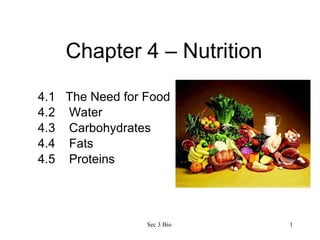
Chapter 4 nutrition 2011
- 1. Chapter 4 – Nutrition 4.1 The Need for Food 4.2 Water 4.3 Carbohydrates 4.4 Fats 4.5 Proteins Sec 3 Bio
- 6. Nutritional label (Food label)
- 14. Digestion of disaccharides by hydrolysis maltose glucose glucose maltase Definition: Hydrolysis is a chemical reaction in which a water molecule is needed to break up a complex molecule into small molecules.
- 16. Test for reducing sugars (Benedict’s Test)
- 18. This equipment is used to find out nutrients found in food products .
- 23. What make up fats? Carbon (C) Hydrogen (H) Oxygen (O) 3 fatty acids glycerol
- 26. Test for Fats (Ethanol Emulsion Test)
- 36. Test for Proteins (Biuret Test)
- 41. Carbohydrates NUTRIENTS may be Functions of water In animals, water: • is a medium for chemical reactions to occur; • transports digested food products, excretory products, and hormones from one part of the body to another; • is an essential part of protoplasm, lubricants, digestive juices and blood; • is essential for hydrolysis; and • helps to control body temperature. Monosaccharides (single sugars), e.g. glucose, fructose and galactose In plants, water: • is essential for photosynthesis; • is needed to keep plant cells turgid; • transports mineral salts from the roots to the leaves; and • transports food substances from the leaves to other parts of the plants. Water Fats Organic compounds made up of carbon, hydrogen and oxygen but they contain much less oxygen in proportion to hydrogen. Organic compounds made up of carbon, hydrogen and oxygen in a ratio of 1 : 2 : 1. Organic compounds made up of carbon, hydrogen, oxygen and nitrogen. Sulphur may also be present. Inorganic nutrient. Water does not contain carbon. Proteins Disaccharides (double sugars), e.g. maltose, lactose and sucrose Polysaccharides (complex carbohydrates) made up of many monosaccharides e.g. Starch Glycogen Cellulose • forms the cell walls in plants; and • cannot be digested by mammals, but is used as fibre in their diet. Identification Test for reducing sugars: A reducing sugar gives a brick-red precipitate when boiled with Benedict’s solution. Sucrose is a non-reducing sugar. • serves as the main form of storage for carbohydrates in green plants; and • gives a blue-black colour with iodine (test for starch). • serves as the main form of storage for carbohydrates in animals and fungi. Basic units Fats are hydrolysed to form fatty acids and glycerol. Identification Test for fats: A cloudy white emulsion is formed in the ethanol emulsion test. Basic units Proteins consist of amino acids linked together by peptide bonds. Identification Test for proteins: Proteins give a violet colouration with Biuret reagent. amino acids polypeptides proteins
Notas del editor
- Concept Map page 69
